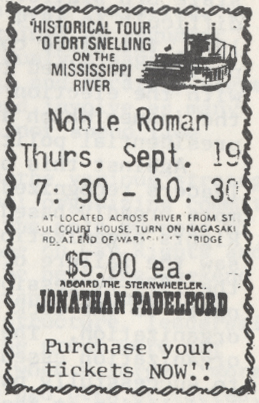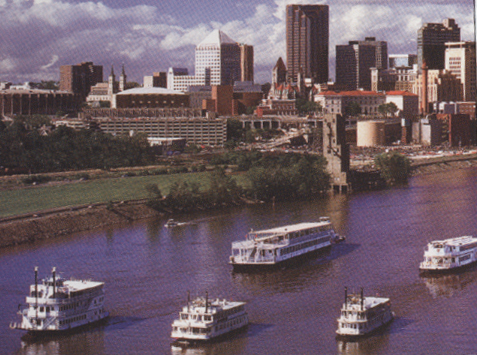Difference between revisions of "Mississippi River"
(table +table) |
|||
| Line 4: | Line 4: | ||
| + | |||
| + | {| {{prettytable}} | ||
| + | ! | ||
| + | ! | ||
| + | |- | ||
| + | | <div style="text-align: center;"> | ||
[[Image:Svc_missip.jpg]] | [[Image:Svc_missip.jpg]] | ||
| + | </div> <div style="text-align: center;"> | ||
| + | <small>'''Advertisement for the first Riverboat Cruise on the Mississippi River from the ''Uptown Voice'' in 1974. Courtesy of the [[Jean-Nickolaus Tretter Collection]].'''</small> | ||
| + | </div> | ||
| + | | The fourth-longest river on Earth is bedrock for the history and culture of America’s heartland. The waterway is a divide where the established urban culture of America’s east meets the pioneer spirit of its dreaming west. | ||
| + | |||
| + | |||
| + | Jazz and the Blues was born in the river’s delta, and the waterway inspired one of the nation’s greatest authors, Mark Twain. One can also attribute the river to the development of many Midwestern cities—thus, one can consider the “Mighty Mississippi” as a place of genesis for queer history in the Midwest. | ||
| + | |||
| + | |||
| + | Long before airplanes or automobiles—and when the railroads were in infancy—waterways were the fastest mode of navigation in the United States. Rivers and the Great Lakes were busy trade routes that shipped natural goods from the heartland to dense populations on the East Coast. With so many resources flowing through the nation’s rivers, pioneering businessmen headed west and established trade centers at commanding confluences. | ||
| + | |} | ||
| + | |||
| + | Minneapolis and St. Paul are uncommon settlements in this regard, as the two cities made use of unique geographic phenomena on the river; Minneapolis used the Mississippi’s only waterfall to power its grain mills before electricity, and St. Paul established itself as a trading center on the waterway’s northernmost steamboat landing. | ||
| + | |||
| + | {| {{prettytable}} | ||
| + | ! | ||
| + | ! | ||
| + | |- | ||
| + | | | ||
| + | |||
| + | Eventually, advances in power and transportation technology made the river less significant to the nation’s economy. Cities were already sited, however—their placement created gravitational pulls that continued with or without their use of the Mississippi. | ||
| + | |||
| + | |||
| + | Decades passed, as did the industrial foundation of cities—by the 1960s, the mighty river had become a polluted mess whose urban shores were abandoned industrial districts. | ||
| + | | <div style="text-align: center;"> | ||
[[Image:Svc_mriver.jpg]] | [[Image:Svc_mriver.jpg]] | ||
| + | </div> <div style="text-align: center;"> | ||
| + | '''<small>Poster Advertisement from the Paddleford Riverboat Copmany, c.1999. Courtesy of the [[Jean-Nickolaus Tretter Collection]].</small>''' | ||
| + | </div> | ||
| + | |} | ||
| + | |||
| + | |||
| + | A few Americans kept the Mississippi’s memory alive. In St. Paul, Captain William D. Bowell Sr. assembled a handful of riverboats beginning in 1969—the Twin Cities Pride committee became one of the captain’s early customers five years later. This began a tradition that continues to this day; stern-wheeler remain a popular Pride venue in 2009. | ||
| + | |||
---- | ---- | ||
| − | + | ||
| + | |||
| + | <small>(1)</small> | ||
| + | |||
| + | <small>(2)</small> | ||
| + | |||
| + | <small>(3)</small> | ||
| + | |||
| + | <small>(4)</small> | ||
| + | |||
| + | <small>(5)</small> | ||
Part of [[Minneapolis/St. Paul, MN: 100 Queer Places in Minnesota History, (1860-1969), (1969-2010)]] | Part of [[Minneapolis/St. Paul, MN: 100 Queer Places in Minnesota History, (1860-1969), (1969-2010)]] | ||
Revision as of 14:29, 25 March 2010
Shared by Minneapolis, St. Paul, St. Louis, Memphis, and New Orleans
| Advertisement for the first Riverboat Cruise on the Mississippi River from the Uptown Voice in 1974. Courtesy of the Jean-Nickolaus Tretter Collection. |
The fourth-longest river on Earth is bedrock for the history and culture of America’s heartland. The waterway is a divide where the established urban culture of America’s east meets the pioneer spirit of its dreaming west.
|
Minneapolis and St. Paul are uncommon settlements in this regard, as the two cities made use of unique geographic phenomena on the river; Minneapolis used the Mississippi’s only waterfall to power its grain mills before electricity, and St. Paul established itself as a trading center on the waterway’s northernmost steamboat landing.
|
Eventually, advances in power and transportation technology made the river less significant to the nation’s economy. Cities were already sited, however—their placement created gravitational pulls that continued with or without their use of the Mississippi.
|
Poster Advertisement from the Paddleford Riverboat Copmany, c.1999. Courtesy of the Jean-Nickolaus Tretter Collection. |
A few Americans kept the Mississippi’s memory alive. In St. Paul, Captain William D. Bowell Sr. assembled a handful of riverboats beginning in 1969—the Twin Cities Pride committee became one of the captain’s early customers five years later. This began a tradition that continues to this day; stern-wheeler remain a popular Pride venue in 2009.
(1)
(2)
(3)
(4)
(5)
Part of Minneapolis/St. Paul, MN: 100 Queer Places in Minnesota History, (1860-1969), (1969-2010)

